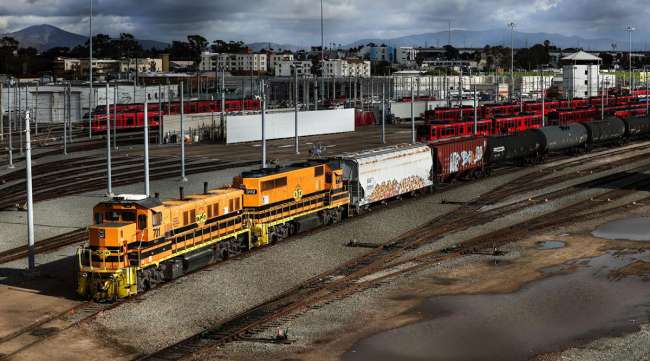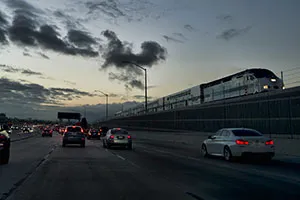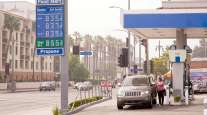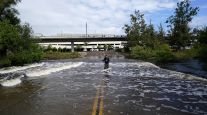The San Diego Union-Tribune
San Diego Freight Trains Keep Running Despite Landslide Risk

[Stay on top of transportation news: Get TTNews in your inbox.]
Freight trains, unlike passenger trains, have resumed running across the tracks beneath a San Clemente, Calif., landslide that continues to threaten San Diego County’s only rail link with the rest of the United States.
That has prompted some people to ask why the route is safe for cargo such as automobiles and building supplies, but not for people. There are several answers to that question.
Safety standards are not the same for freight trains and passenger trains, according to an official at the Federal Railroad Administration, the regulatory agency that sets the standards and guidelines for the rail industry.
Visual track inspections normally are required twice a week for passenger trains, compared to once a week for freight trains, as outlined in the Code of Federal Regulations. Also, there’s a separate category of equipment safety standards for passenger trains.
Extra caution and vigilance may be exercised when restricting passenger operations over an area that has experienced repeated flooding, landslides and washouts, the FRA official said. In such instances, the railroad that owns the right-of-way, which at San Clemente is the Orange County Transit Authority, may impose temporary suspensions or moratoriums on passenger or freight trains to reduce risks.
The FRA does not require a minimum crew size for freight trains, but industry practice is to have two people, a certified locomotive engineer and a certified conductor, on most runs.
The federal agency has issued national safety advisories as recently as Nov. 20, providing guidance to the rail industry on severe weather and climate effects.
The agency has no regulations specific to the identification of landslide risks, but it “has confidence in the precautionary actions being taken by the railroads at San Clemente to ensure operating safety on this line,” the official said.

Levin
State Rep. Mike Levin (D-Calif.) is a strong advocate for improvements to the coastal rail corridor. On Feb. 2 he said he has been communicating with OCTA officials to emphasize reopening the tracks “as quickly and safely as possible.”
“The longer the corridor is out of service, the greater the impact this landslide will have on our region,” said Levin, whose district includes coastal cities from Laguna Niguel to Del Mar. “I’m confident OCTA will take all the appropriate precautions when determining the usability of the tracks and hope that the tracks can safely resume service soon.”
The railroad has wide-ranging economic impacts on the region.
The corridor supports more than $1 billion in annual freight volume carried by two railroad companies — Burlington Northern and Santa Fe, or BNSF, and Union Pacific — serving seaports in San Diego, Long Beach, Los Angeles and Port Hueneme, according to the California Senate Office of Research.
Amtrak’s Pacific Surfliner intercity trains had more than 1.6 million passengers in 2022 on the 351-mile LOSSAN corridor between San Diego and San Luis Obispo, according to statistics provided by Caltrans. Metrolink and North County Transit District’s Coaster trains had a total of 5 million passengers in 2022.
State Sen. Catherine Blakespear (D-Calif.) is leading an effort to have the California State Transportation Agency take a larger role in overseeing the rail corridor. As chair of the Senate’s LOSSAN Corridor Resiliency Subcommittee, she found that the multiple independent agencies using the corridor complicate issues, including responses to rail closures, and make planning difficult.
The LOSSAN corridor also is part of Defense Department’s Strategic Rail Corridor Network, which links military bases across the United States, including Camp Pendleton and Naval Base San Diego.
Gov. Gavin Newsom signed a bill in July extending the three-year deadline to 2026 for work under Assembly Bill 66, which secured $2.5 million in the state budget for research that could lead to an early warning system for landslides and cliff erosion in hot spots such as Del Mar and San Clemente.
The study is led by coastal geomorphologist Adam Young and research geophysicist Mark Zumberge, both of the Scripps Institution of Oceanography at the University of California San Diego. Their work uses ground-monitoring devices and Light Detection and Ranging (LiDAR), a system that scans the cliffs with lasers to create three-dimensional maps of the coast.

Zumberge
“We aim to gain a better understanding of the processes leading up to cliff failures,” Zumberge said last year. “Our goal is to learn how deformations are impacted by tides, large surf, groundwater and rainfall to see if we can answer the question of whether signals exist that can forecast where and when an increased risk for collapse is developing.”
OCTA and Metrolink officials said late Feb. 2 they plan to build a barrier wall to protect the tracks while work continues on the Mariposa landslide.
No details were released, but last year they built a barrier wall below a different slide at San Clemente’s Casa Romantica, a historic bluff-top estate that holds special community events. That wall, erected along the railroad right-of-way, was about 300 feet long and 12 feet to 15 feet high, made of steel pilings and wooden timbers.
“The path forward could include restoring limited passenger rail service during construction of the wall, but no timeline for letting passenger trains run again has been determined at this point,” states an OCTA news release. “The safety of passengers, as always, will guide that decision.”
Last week, Caltrans declared the Marisposa slide to be an official emergency, clearing the way for up to $10 million in state emergency funding for repairs.
Safety is always a concern, of course, but logistics also are a factor in when passenger service will resume at the San Clemente site, transit officials said.
Freight usually travels at night to avoid passenger trains. In the slide area, the night moves also prevent conflicts with repair crews working only in daylight hours.
During the day, crews use heavy equipment such as cranes, bulldozers and skip loaders, and there is no room for trains to pass. No roads reach the Mariposa hillside site, and the narrow railroad right-of-way provides the only access.
For the past week, BNSF trains were allowed through only between 9 p.m. and 3 a.m., and the speed limit was 10 mph.

A Metrolink train passes as commuters drive south down Interstate 5 in Los Angeles in 2018. (Richard Vogel/Associated Press)
“Inspections of the track and a confirmation that it is safe to proceed will occur before and after each freight train passes,” a Metrolink spokesperson said, and work crews will remain on-site throughout the impending rain.
“At this point it’s all visual inspection,” said Scott Johnson, Metrolink director of communications.
The engineer drives the train through the trouble spot at 10 mph, slow enough to stop if they see anything on the tracks, Johnson said Feb. 3. A geological technician on the hillside also watches for any recent soil movement that could threaten the train.
Freight trains can be quite long, as many as 40 or 50 cars, unlike passenger trains that are usually just three or four cars. Rail officials have said the weight of a freight train is not much of a safety factor, but its length and the time it takes to slowly travel through a trouble spot can cause problems.
A long freight train can monopolize a section of track and even the entire rail corridor, because there is only a single set of rails in places such as southern Orange County, the Del Mar bluffs and downtown Carlsbad. Those places can be bottlenecks when multiple trains are on the corridor.
Trains need a second set of tracks to pass each other. Regional planners have been working for years to double-track the rail corridor, but so far only about three-quarters of the stretch between San Diego and San Clemente has the double capacity.
Also, freight trains run on an as-needed basis, one at a time with no set schedule. They don’t necessarily make round trips. Passenger trains must make round trips scheduled at specific times throughout each day so commuters and travelers can reach their destinations without delay.
How does hydrogen fuel cell technology fit into freight transportation? Find out with Parker Meeks, the CEO of Hyzon, a company that designs and manufactures fuel cell technology for heavy-duty transport applications. Tune in above or by going to RoadSigns.ttnews.com.
Amtrak alone has 15 round-trip trains between San Diego and Los Angeles on a normal weekday.
Further, each agency is responsible for its own actions. BNSF decides whether its trains are safe to travel, as do Amtrak, Metrolink, and North County Transit District.
BNSF has not responded to emails requesting comment on the San Clemente slide and the hazard it may represent. Amtrak, Metrolink and NCTD have long said passenger safety is their utmost priority.
A spokesperson at the National Transportation Safety Board referred questions about rail safety to the Federal Railroad Administration.
Landslides should be no surprise on the rugged California coast, where trains have traveled basically the same route for 120 years or longer.
Most of the slides are in places where they have occurred before. Unlike a mountaintop avalanche, coastal land slips often start slowly with cracks in the soil or a few loose boulders. Some move only inches or less per day.
San Clemente officials detected soil movement at the Mariposa Pedestrian Bridge and closed the trail there more than a week before debris fell onto the tracks. The slide has slowed since then, but late last week it continued to move slowly.
The Mariposa slide is the third location in San Clemente where recurring landslides have stopped trains repeatedly in recent years.
The previous slide, at Casa Romantica, is still being repaired with completion several months away.
Before that, a slow-moving slide below the Cyprus Shore community suspended passenger service for almost six months while repairs were completed. Freight trains were allowed through at slow speeds at night during most of the work.
Heavy rain or an earthquake still can precipitate a sudden disaster for the railroad, just as it could for a tall building or a freeway overpass.
Want more news? Listen to today's daily briefing above or go here for more info
Drainage and groundwater flow at the Mariposa site are being monitored constantly, transit officials said.
“The topography of the area has changed due to the landslide itself,” states one of several recent updates to the OCTA website.
“The project team placed additional pipes and ballast to integrate with the existing culvert system to further improve water drainage from the saturated hillside,” it states.
“In addition to continuing the grading and excavation, work was performed to reestablish a culvert inlet on the inland side of the track that was covered by landslide debris,” it states. “In order to keep the culvert functioning, approximately 30 tons of riprap was placed to ensure proper water drainage.”
Plastic sheeting was placed over the slope to slow the infiltration of water during the rain, possibly heavy, expected over the next few days.
Distributed by Tribune Content Agency, LLC





